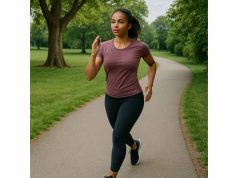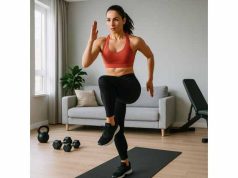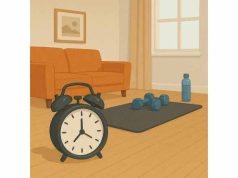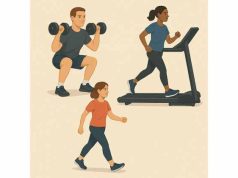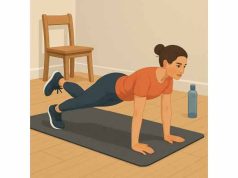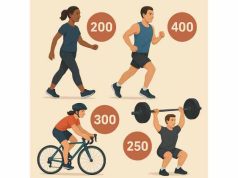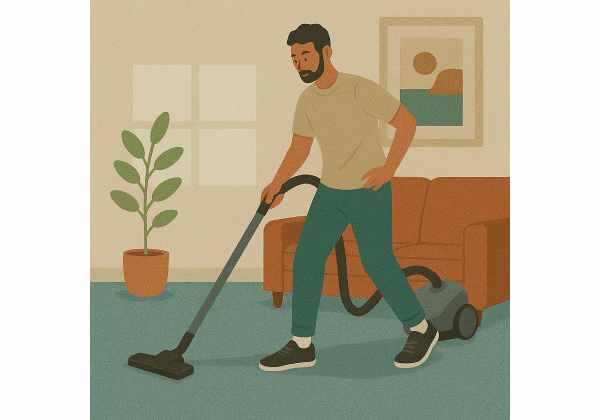
Formal workouts matter, but the quiet calories you burn between them can matter more. Non-exercise activity thermogenesis—NEAT—covers everything from standing, walking for errands, and climbing stairs to chores and fidgeting. These small movements add up across long days and busy weeks, making weight loss more forgiving and maintenance more realistic. In this guide, you’ll learn what NEAT is, how much it can contribute, and exactly how to raise it without turning your life into a step challenge. If you’re also planning gym sessions, see our overview of strength, cardio, and steps to pair NEAT with structured training.
Table of Contents
- What NEAT actually is
- NEAT and weight loss
- How to increase NEAT
- At-home and office ideas
- Tracking NEAT without obsessing
- Common mistakes and myths
- NEAT for different lifestyles
- Frequently Asked Questions
- Health Disclaimer
What NEAT actually is
NEAT stands for non-exercise activity thermogenesis—the energy you expend outside of sleeping, eating, and deliberate workouts. Think of it as the “background burn” of daily life: walking to the bus, carrying groceries, mowing the lawn, pacing on calls, even animated gestures while you talk. Because these movements are woven into hours of waking time, they can rival—or exceed—the calories you burn in the gym.
To place NEAT in context, consider the pieces of your total daily energy expenditure (TDEE):
- Basal metabolic rate (BMR): Energy to run your body at rest—breathing, circulation, cell repair.
- Thermic effect of food (TEF): Energy cost of digesting and absorbing meals.
- Exercise activity (EAT): Energy from structured workouts—runs, rides, lifting sessions.
- NEAT: All the “everything else” movement.
For many adults, BMR is the largest piece, but NEAT is the most variable piece. Two people with similar workouts can differ by hundreds of daily calories because one walks, stairs, and stands more. That gap compounds over weeks. When weight loss slows, small increases in NEAT often unlock progress without raising training stress or hunger the way additional high-intensity exercise can.
Why NEAT matters for weight loss:
- It is sustainable. NEAT relies on tiny, repeatable choices, not will-power for intense sessions. You can do it every day, even on rest days.
- It preserves recovery. Low-intensity movement burns energy with minimal muscle damage and little need for extra recovery time.
- It buffers sedentary time. Sitting for long blocks is linked with stiff joints, low mood, and lower spontaneous movement. Short “NEAT breaks” mitigate these effects.
Where NEAT shows up: walking commutes, household chores, gardening, standing to read, playing with kids, taking stairs, light DIY projects, active hobbies, walking meetings, parking farther away, and short movement snacks scattered through the day.
Key idea: NEAT is not a replacement for training; it is the base layer that keeps your daily energy burn higher and more stable. Build your plan on both. For step-by-step fat-loss fundamentals, review our concise guide to safe weight-loss basics and then return here to design your NEAT strategy.
NEAT and weight loss
Weight changes reflect energy balance across weeks. You influence that balance with what you eat and how much you move. Formal workouts help, but they occupy a small slice of time. NEAT spreads across the remaining hours, which is why it meaningfully shifts your average daily burn.
How much can NEAT add? Numbers vary widely. A desk-bound day with few breaks might net a modest NEAT contribution. A day with commuting on foot, standing tasks, chores, and 8,000–12,000 steps can add a few hundred calories without “feeling” like exercise. The exact figure depends on body size, pace, terrain, and habits. For context when comparing activities, browse our concise calorie burn estimates to calibrate expectations.
Why NEAT often beats “more cardio” for adherence:
- Lower friction: You do not need equipment, special clothes, or dedicated time blocks. Minutes slip into existing routines.
- Less recovery cost: Easy movement rarely requires a next-day tradeoff. You keep strength and interval work high-quality.
- Behavior stacking: Linking movement to daily tasks—coffee, meetings, school drop-off—makes consistency automatic.
What NEAT cannot do: It will not fully replace progressive strength training for muscle retention, nor will it create the cardiorespiratory adaptations targeted by structured aerobic work. NEAT is the “always on” assistant. Strength and cardio are the specialists. Use all three.
How NEAT interacts with appetite: Low-intensity activity tends to shift appetite modestly, not dramatically. Many people find NEAT easier to pair with steady eating than high-intensity sessions, which can spike hunger later. If you notice “compensation”—bigger portions or unplanned snacks—plan protein- and fiber-rich meals and keep calorie-dense foods less visible in the evening.
Practical target: If you currently average fewer than 5,000 steps, aim first for 6,500–8,000 on most days. If you’re already at 8,000–10,000, push toward a higher weekly average rather than a single heroic day. Small, persistent increases are the path to sustainable fat loss and weight maintenance.
How to increase NEAT
Raising NEAT is simpler than overhauling your workout plan. You will build triggers that cue movement automatically across your day. Start with one to three ideas, master them for two weeks, and then layer in more.
1) Anchor movement to existing habits
- After waking: A 5–10-minute neighborhood loop or light mobility while coffee brews.
- Before meals: Two to five minutes of walking around the block; it aids glucose control and adds steps.
- During calls: Walk, pace, or stand. Keep a headset nearby so it’s effortless.
- After work: A decompression walk before dinner reduces stress-driven snacking.
2) Engineer your environment
- Place a resistance band or light kettlebell near your workstation. Use it every break for 1–2 sets of simple moves.
- Adopt a “stair first” rule in buildings under six floors. In elevators, get off one floor early.
- Park at the far end of lots and get off public transport one stop early when time allows.
- Use a non-distracting timer (e.g., 25-minute focus, 5-minute movement). Repeat through the day.
3) Build micro-routines (1–5 minutes)
- Movement snack A: 30 bodyweight squats + 30 marching steps + 10 push-ups on a counter.
- Movement snack B: 60-second wall sit + 1–2 flights of stairs + 30-second calf raises.
- Movement snack C: 1–2 minutes of brisk hallway walking + shoulder circles + band pull-aparts.
4) Use weekends strategically
- Batch errands on foot in walkable areas.
- Plan an active chore block: yardwork, cleaning, light DIY.
- Pair social time with movement—walk-and-talk coffee instead of sitting.
5) For desk-heavy roles
Follow a simple cadence: sit for focus work, stand for calls, walk for thinking. Rotate positions every 30–60 minutes. For a complete weekday structure with breaks and quick circuits, see our movement plan for desk jobs.
Progress approach: Add 1,000–2,000 steps to your current daily average for two weeks. If energy and sleep are steady, add another 1,000. Keep formal training intact; NEAT should support, not replace, your lifts and aerobic sessions.
At-home and office ideas
You do not need a treadmill desk to raise NEAT. These low-effort options work in small apartments, shared offices, and busy homes.
Home routines
- Chore circuits: Set a 20-minute timer. Cycle laundry, dishes, and floor care without breaks. Music helps pace but keep it practical.
- Commercial breaks: During TV, stand for one ad and walk in place for the next. Climb a flight of stairs between episodes.
- Kid time: Hide-and-seek, dance to one song, or a quick backyard game. Aim for movement-first play.
Office routines
- Switch to walk-and-talk for one short meeting daily.
- Adopt a “last-mile” habit: park or exit transit a few blocks away if safety and time permit.
- Keep a light pair of shoes and weather-ready jacket at work for spontaneous walks.
- Stand to read long emails; walk while drafting with voice notes, then edit seated.
Errand strategies
- Choose stores within a walkable cluster and loop them in one trip.
- Carry a basket instead of a cart for small grocery runs.
- Use stairs in transit hubs and office towers whenever possible.
If walking is your preferred anchor activity, review our primer on walking for weight loss to set pace targets, incline ideas, and weekly progressions that dovetail with NEAT.
Tracking NEAT without obsessing
Track just enough to guide action. The goal is informed adjustments, not perfect accounting.
1) Steps as your main proxy
Steps are convenient, device-agnostic, and comparable across days. Use a 7-day rolling average to smooth noise. If fat loss stalls for two weeks and nutrition is steady, raise your average by ~1,000–2,000 steps and reassess.
2) Time-in-motion
Many watches report “move minutes” or “active minutes.” Treat these as secondary; they capture intensity but miss light movement. Aim to move at least 2–5 minutes each half hour you are awake and not driving.
3) Standing time*
Standing is not a calorie bonanza, but it breaks up sedentary hours and cues spontaneous movement. Rotate sit/stand; avoid long, locked-knee stands. If a device tracks “stand hours,” shoot for 8–12 hours with at least one brief movement per hour.
4) Guardrails to prevent obsession
- Pick one primary metric (steps) and one backup (move minutes). Avoid chasing all metrics daily.
- Track weekly averages, not single days.
- Set ceilings too: if sleep dips, cap late-night step accumulation and shift to earlier windows.
5) Calibrating expectations
Last, tie your tracking to a simple plan. If your daily average sits around 7,000 and your goal is weight loss, use our 10,000 steps guidance to decide whether to raise steps or redistribute them across the day for fewer long sitting blocks.
Common mistakes and myths
“I’ll just stand all day.” Standing helps you interrupt sitting, but it is not a substitute for moving. Alternate sitting, standing, and short walks. A minute of stairs generally outperforms a minute of passive standing for energy burn and comfort.
“Fidgeting equals a workout.” Fidgeting contributes, but it is small compared with purposeful walking. Treat fidgets as bonus calories, not your main strategy.
“More NEAT means I can skip training.” NEAT supports fat loss; strength training preserves muscle and bone, and structured cardio builds fitness. For a complete weekly plan, review our plain-English guide to exercise options for weight loss and slot NEAT around it.
“Compensation will erase everything.” Some people eat more when they move more, but the effect is not guaranteed or uniform. Plan protein-rich meals, keep snack foods out of easy reach, and drink water before meals to keep compensation in check.
“Evenings are off-limits.” Gentle evening walks are compatible with good sleep for most people. If late activity keeps you alert, pull NEAT earlier and favor dim, quiet wind-down routines at night.
“I need a treadmill desk.” Helpful for some, unnecessary for most. You can accumulate impressive NEAT with stairs, walks, chores, and brief movement snacks in normal environments.
NEAT for different lifestyles
Parents and caregivers — Make movement social and predictable: school-run loops, stroller walks after meals, park play where you move too, and short cleanup sprints before bedtime. Keep a small “go bag” (hat, shoes, water) ready to seize good weather.
Students — Walk campus edges between classes, take stairs in libraries, and use 25/5 or 50/10 study-break rhythms. Preview next day’s schedule and mark two short walking blocks you will keep regardless of deadlines.
Desk-heavy professionals — Convert one recurring meeting into a walk-and-talk. Use a headset for calls, stand for review tasks, and pace while brainstorming. Book calendar holds labeled “focus + 5-min walk” to guard movement breaks.
Shift workers — Anchor NEAT to shift boundaries: 10-minute walk before clock-in, 5 minutes mid-shift, 10 minutes after clock-out. Choose bright-light outdoor walks during wake windows and avoid strenuous late-night activity if it disturbs sleep.
Older adults — Favor joint-friendly NEAT: gentle loops on soft paths, light gardening, water aerobics as active leisure, and frequent sit-to-stand transitions. Use handrails on stairs, and choose smaller, more frequent walks for balance and comfort.
Injury or pain — Keep intensity low and frequency high. Try short flat walks, pool walking, or stationary cycling at easy resistance. If weight-bearing is limited, accumulate steps in short bouts and add seated mobility to maintain circulation. Consult your clinician if symptoms persist.
Bad weather or limited space — Use hallway laps, stairwells, marching in place, or simple circuits between rooms. Bundle calls with gentle pacing. Keep a compact toolkit (band, jump rope for gentle swings, light dumbbell) to make movement snacks friction-free.
Frequently Asked Questions
How many steps count as NEAT?
All steps outside formal workouts count toward NEAT. There is no “magic” number, but 6,500–10,000 daily steps suits most adults for fat loss and health, depending on size and schedule. Track a weekly average, then add 1,000–2,000 steps if progress stalls for two weeks.
Does a standing desk burn many calories?
Standing raises energy use slightly versus sitting, but the difference is modest. Its real value is breaking long sedentary blocks. Rotate sitting, standing, and short walks. Brief movement—stairs, hallway loops—adds more than hours of passive standing.
Is fidgeting a meaningful NEAT strategy?
Fidgeting contributes small amounts and varies by person. Treat it as a bonus, not a plan. Purposeful walking, chores, and frequent short breaks reliably add more energy expenditure without taxing recovery or requiring extra time blocks.
What’s the best pace for NEAT walking?
Comfortable, conversational pace is ideal for NEAT—often 3–4 mph (5–6.5 km/h) on flat ground. On hills or stairs, slow down. Save faster intervals for workouts. The goal is repeatable daily movement, not fatigue that competes with training.
Should I keep NEAT high on rest days?
Yes. Easy movement promotes recovery and keeps weekly energy burn steady. Use gentle walks, chores, and mobility. Avoid turning rest days into hidden interval sessions; keep intensity low and distribute steps across the day.
How soon will higher NEAT show results?
Expect subtle changes within one to two weeks: steadier energy, better mood, and easier adherence to calorie targets. Scale and measurements typically reflect consistent NEAT after two to four weeks, provided your nutrition aligns with your goal.
References
- Daily steps and all-cause mortality: a meta-analysis of 15 international cohorts (2022) (Systematic Review/Meta-analysis)
- After Dinner Rest a While, After Supper Walk a Mile? A Systematic Review with Meta-analysis on the Acute Postprandial Glycemic Response to Exercise Before and After Meal Ingestion in Healthy Subjects and Patients with Impaired Glucose Tolerance (2023) (Systematic Review/Meta-analysis)
- World Health Organization 2020 guidelines on physical activity and sedentary behaviour (2020) (Guideline)
- Differences of energy expenditure while sitting versus standing: A systematic review and meta-analysis (2018) (Systematic Review/Meta-analysis)
- Non-exercise activity thermogenesis in the workplace: The office is on fire (2022) (Review)
Health Disclaimer
The information in this article is educational and general in nature. It does not replace personalized advice from your physician, registered dietitian, or qualified fitness professional. If you have medical conditions, take medications, are pregnant or postpartum, or are new to activity, consult a healthcare provider before changing your daily movement or exercise plan.
If this guide was useful, consider sharing it with someone who spends long hours at a desk. You’re welcome to follow us on Facebook or X for practical tips and new program releases. Thank you for reading and for prioritizing your health.

